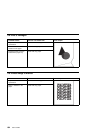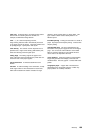device-independent interface for controlling and
managing all-points addressable printers.
interface. A shared boundary. An interface might be a
hardware component to link two devices or it might be a
portion of storage or registers accessed by two or more
computer programs.
IPDS. See Intelligent Printer Data Stream.
intervention. An unexpected condition that requires
user intervention to clear it, for example, out of toner.
ISO sizes. Pertaining to a set of paper sizes selected
from those standardized by the International
Organization for Standardization (ISO) for use in data
processing.
jam. In a printer, a condition where forms have become
blocked or wedged in the forms path so the printer
cannot operate.
JIS. Japanese Industry Standards. Used in reference
to paper standards for size.
landscape orientation. Text and images that are
printed parallel to the longer side of the forms. Contrast
with portrait orientation.
laser (light amplification by stimulated emission of
radiation). A device that emits a beam of coherent
light.
legal-size paper. Paper that is 216 mm x 356 mm (8.5
in. x 14.0 in.).
letter-size paper. Paper that is 216 mm x 279 mm (8.5
in. x 11.0 in.).
logical page. The print on the page, such as
composed text, graphics, and fonts within defined
margins. See also page. Contrast with physical page.
MRT compression. Memory Reduction Technology
algorithms to compress printed pages into smaller
memory space.
network interface cards. Optional features that allow
the printer to attach to computer networks. The printer
can have up to two network interface cards installed,
allowing it to communicate with two networks.
offline. Not connected to an installed and enabled
attachment. Contrast with online.
offset stacking. The jogged stacking of output media
in the output stacker so that jobs protrude from the
balance of the stack to give physical identification.
online. Connected to an installed and enabled
attachment. Contrast with offline.
orientation. The number of degrees an object is
rotated relative to a reference; for example, the
orientation of an overlay relative to the page point of
origin. See also text orientation.
output bin. The part of the printer where the printed
sheets are collected.
outline font. A font whose graphic character shapes
are defined by mathematical equations rather than by
raster patterns. Contrast with raster font.
overrun condition. Loss of data because a receiving
device is unable to accept data at the rate it is
transmitted.
page. A collection of information bound by the
beginning page control and its associated end control. A
page of printing is one side of a sheet of paper or form.
See also logical page and physical page.
paper path. The entire route that forms travel while
they are being processed. The paper path usually
begins where the forms are loaded and ends at the
stacker.
parallel port. An access point through which a
computer transmits or receives data that consists of
several bits sent simultaneously on separate wires.
PCL5e. Hewlett-Packard's Printer Command Language,
a data stream used for printing.
pel (picture element). (1) An element of a raster
pattern; a point where a toned area on the
photoconductor may appear. (2) On an
all-points-addressable output medium, each pel is an
addressable unit. On a row-column addressable output
medium, the only pel addressable is the beginning of a
character cell.
physical page. The form on which the printer is
printing, such as an 8-1/2 x 11-inch sheet of paper. See
also page. Contrast with logical page.
pitch. A unit of measurement for the width of a printed
character. It identifies the number of graphic characters
per inch; for example, 10-pitch has ten graphic
Glossary
187


















